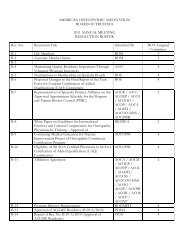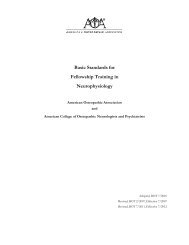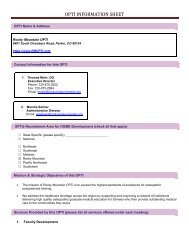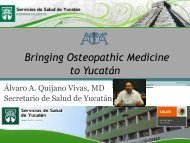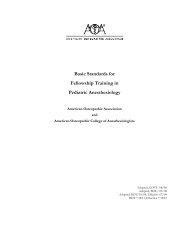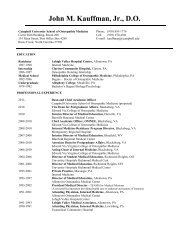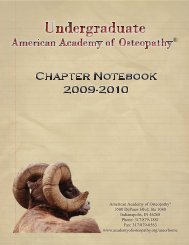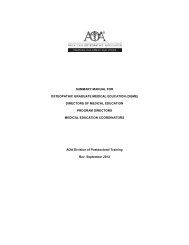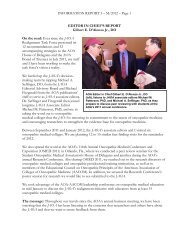ProloTherapy of the Low Back (including Sacroiliac Areas)
ProloTherapy of the Low Back (including Sacroiliac Areas)
ProloTherapy of the Low Back (including Sacroiliac Areas)
You also want an ePaper? Increase the reach of your titles
YUMPU automatically turns print PDFs into web optimized ePapers that Google loves.
Arden Andersen, D.O.<br />
AOA Convention, October 2012,<br />
San Diego, CA
The lumbar spine and sacral-iliac carry <strong>the</strong><br />
weight <strong>of</strong> <strong>the</strong> body and payload, maintain <strong>the</strong><br />
scaffolding for <strong>the</strong> body core muscles and<br />
allow humans to stand erect.
One <strong>of</strong> <strong>the</strong> most common areas <strong>of</strong> pain,<br />
injury, invasive and non-invasive <strong>the</strong>rapy<br />
from steroid injections to decompression,<br />
from OMT to laser spine surgery<br />
One <strong>of</strong> <strong>the</strong> most amenable areas to successful<br />
prolo<strong>the</strong>rapy<br />
One <strong>of</strong> <strong>the</strong> easiest areas to inject as a<br />
beginner and gain success and confidence
<strong>Low</strong> back injury at age 18, perhaps before as well<br />
on <strong>the</strong> farm, chiropractic relieved/saved me from<br />
exploratory surgery<br />
During medical school had significant pain,<br />
disability treated 5 days per week with OMT,<br />
cranio-sacral and exercises without resolution.<br />
Finally had prolo<strong>the</strong>rapy at AOAPRM seminars<br />
and got resolution <strong>of</strong> pain for over 5 years,<br />
reinjured/Levaquin and now getting prolo<strong>the</strong>rapy<br />
again with improvement<br />
Nothing has been as effective as prolo<strong>the</strong>rapy
‣ OMT/chiropractic doesn’t hold<br />
‣ Ligament structure are tender to exam<br />
‣ Ilio lumbar attachments to iliac area are tender<br />
‣ Inter spinous ligaments origin/insertion is<br />
tender, painful to touch<br />
‣ Pain’s less when mobile. (The patient is in less<br />
pain while in motion, but hurts more when still or<br />
on arising in <strong>the</strong> morning.)<br />
‣ Local Anes<strong>the</strong>tic is diagnostic if all or most<br />
symptoms are gone by 10-15 minutes after <strong>the</strong><br />
areas to receive prolo have been anes<strong>the</strong>tized.<br />
(thus ruling out pain from non-ligament causes)
Rule Out: – lose style points for missing <strong>the</strong>se<br />
◦ neoplasm<br />
aneurism<br />
appendicitis<br />
peritonitis<br />
kidney infection<br />
shingles<br />
bladder infection<br />
failed surgery<br />
infectious processes
Any pain not <strong>of</strong> fibrous tissue en<strong>the</strong>sitis<br />
origin<br />
Nerve root impingement due to disc<br />
fragmentation which compresses a nerve root<br />
True spinal stenosis – relative as <strong>the</strong>y may<br />
still benefit from prolo<strong>the</strong>rapy before or after<br />
surgical intervention<br />
Muscle atrophy <strong>of</strong> ei<strong>the</strong>r lower extremities<br />
Keep in mind that patient may have already<br />
exhausted o<strong>the</strong>r options or refuses to go<br />
anywhere else – YOU are it!
‣ A preponderance <strong>of</strong> pain receptors are<br />
located in or on ligamentous tissue.<br />
‣ When a legamentous area is tender upon<br />
palpitation, it is due to <strong>the</strong> pain receptors on<br />
<strong>the</strong> remaining intact fibers being over<br />
stretched. For example, apply a pull on a<br />
patch <strong>of</strong> scalp hair containing 100 or more<br />
hairs. Then apply <strong>the</strong> same force on 10 hairs.<br />
The ten hairs represent <strong>the</strong> weakened<br />
ligament. This usually is well accepted by <strong>the</strong><br />
patient.
Why are we doing this?<br />
What is our goal?<br />
◦ Full disclosure and signed consent form<br />
◦ What is <strong>the</strong> patient to expect over <strong>the</strong> next few days<br />
◦ Is patient allergic to anything? Specifically local<br />
anes<strong>the</strong>tics, corn, oils, etc.<br />
◦ Are we merely giving local blocks to determine<br />
diagnosis with actual treatment later?<br />
• Depends upon time allotted for appointment<br />
• Patient expectations or apprehensions
Study !
Study !<br />
Study !
Study !<br />
Study !<br />
Study !
Ask<br />
<strong>the</strong><br />
patient<br />
where<br />
is <strong>the</strong><br />
pain?
Sclerotomes<br />
vs.<br />
Dermatomes
“Sclerotomal” pain in <strong>the</strong> lower extremities may be<br />
noted- study <strong>the</strong> “old” sclerotome charts which<br />
show referred pain <strong>of</strong> ligament (not nerve root)<br />
origin.
Take a<br />
good<br />
history
And ASK
And<br />
TOUCH<br />
<strong>the</strong><br />
patient!!
More<br />
study! =
More<br />
Success
KNOW<br />
THY<br />
ANATOMY
Special Points
Additional<br />
points <strong>of</strong><br />
interest
Know<br />
This<br />
By Heart
I prefer to mark <strong>the</strong> patient’s land marks<br />
◦ Locate <strong>the</strong> iliac crest bilaterally and mark L4<br />
spinous process, <strong>the</strong> remainder <strong>of</strong> <strong>the</strong> lumbar and<br />
sacral spinous processes, SI joints and iliac borders<br />
◦ You can mark <strong>the</strong> key Hackett points A, B, C, D
The most important aspect is to inject <strong>the</strong> painful<br />
areas <strong>of</strong> ligamentous injury/laxity. Many doctors<br />
do not pre-anes<strong>the</strong>tize and most doctors have<br />
<strong>the</strong>ir patients lie down for injections.<br />
I prefer to pre-anes<strong>the</strong>tize <strong>the</strong> spine area and<br />
knees and I have <strong>the</strong> patients sitting up. That is<br />
my comfort, yours may be different – get<br />
comfortable.<br />
Observe various practioners and develop <strong>the</strong><br />
techniques that work best for you in your<br />
practice.
Locate <strong>the</strong> SP with palpation and insert <strong>the</strong><br />
needle to bone, inject ¼ - ½ cc while<br />
retracting <strong>the</strong> needle and reinsert <strong>the</strong> needle<br />
through <strong>the</strong> interspinous ligament to contact<br />
on <strong>the</strong> top <strong>of</strong> <strong>the</strong> spinous process below;<br />
inject ½ to 1cc while retracting <strong>the</strong> needle<br />
Repeat this process for each vertebra<br />
Inject over <strong>the</strong> SI joints, PSIS and o<strong>the</strong>r painful<br />
areas.
Locate <strong>the</strong> SP with palpation and insert <strong>the</strong> needle<br />
to bone, inject ¼ - ½ cc while retracting <strong>the</strong> needle<br />
just <strong>of</strong>f <strong>the</strong> bone and reinsert <strong>the</strong> needle through<br />
<strong>the</strong> interspinous ligament to contact on <strong>the</strong> top <strong>of</strong><br />
<strong>the</strong> spinous process below; inject ½ to 1cc while<br />
retracting <strong>the</strong> needle within <strong>the</strong> ligament. One can<br />
slide <strong>the</strong> needle down <strong>the</strong> side <strong>of</strong> <strong>the</strong> spinous<br />
process to <strong>the</strong> lamina and inject ¼ to ½ cc <strong>of</strong> prolo<br />
solution.<br />
Repeat this process for each vertebra<br />
If needed one can inject on <strong>the</strong> transverse process if<br />
<strong>the</strong> pain pattern dictates such a need.
Lady just over 5’ and near 300 lbs.<br />
◦ Needed a 2” needle to contact <strong>the</strong> SP<br />
◦ Had nearly as much cleavage in back as in front<br />
◦ Thoracic and LS pain complaints<br />
◦ Good improvement with just SP and Interspinous<br />
ligament injections in <strong>the</strong> thoracic and lumbar plus<br />
ilio-lumbar ligament injection bilaterally using 4”<br />
22ga. needle
Needle point<br />
traverses<br />
interspinous<br />
space/ligament
Anes<strong>the</strong>tic<br />
needle<br />
contacts bone<br />
or desired<br />
depth
Inject 1cc<br />
anes<strong>the</strong>tic<br />
with slow<br />
withdrawal <strong>of</strong><br />
needle
Continue flow<br />
<strong>of</strong> anes<strong>the</strong>tic<br />
until needle is<br />
sub-Q
Deposit 0.5cc<br />
prolo-solution
Inadvertent<br />
ontact <strong>of</strong> needle<br />
point against<br />
spinal cord
Deposition <strong>of</strong> solution –<br />
lamina
Needle point<br />
on fascet
Inject with Bone<br />
Contact
Optioninject<br />
segment<br />
below
Injection<br />
Point
Review<br />
Review
L/S- S/I injection
L5 transverse process
Sacral Base
L5 fascet
Iliac crest
Iliac crest, lower
Iliac crest, upper S/I
Mid S/I
Needle<br />
point on<br />
ilium
Needle<br />
point on<br />
lower ilium
Needle point on lower sacral<br />
en<strong>the</strong>sis area
12 cc syringe<br />
Xylo 2% w epi- 2cc<br />
Pumice Solution 4cc<br />
50% Dextrose 4cc<br />
PQU 1cc<br />
Q.S. Sterile Water to 12-13 cc total volume12 cc syringe<br />
Xylo 2% w epi- 2cc<br />
Pumice Solution 4cc<br />
50% Dextrose 4cc<br />
PQU 1cc<br />
Q.S. Sterile Water to 12-13 cc total volume
Keep syringe horizontal as able…<br />
Keep syringe in motion(rotation)<br />
Retract plunger before every point injected<br />
Point needle upwards between punctures<br />
Change needle if retraction x 3 does not reestablish<br />
flow <strong>of</strong> medication
12 cc syringe<br />
50% Dextrose 4cc<br />
Pumice-Lidocaine Solution 6 cc<br />
PQU ½ cc<br />
Sodium Moruate ½ cc<br />
B-complex 1 cc (address <strong>the</strong> stress <strong>of</strong> <strong>the</strong> procedure on <strong>the</strong><br />
person)<br />
Q.S. Sterile Water to 12-13 cc total volume12 cc syringe
I explain to patients <strong>the</strong>y will need 3 to 5 sessions before we make <strong>the</strong><br />
decision about results.<br />
They must have protein before <strong>the</strong> procedure. Ex: N/V after injections<br />
Many patients only need 3 sessions for significant to complete pain<br />
relief. (not usually true with lidocaine and glucose alone)<br />
Each session I chase <strong>the</strong> painful points and end when <strong>the</strong>ir painful<br />
points are no longer. I will use two syringes <strong>of</strong> solution on <strong>the</strong> typical<br />
low back.<br />
I alter <strong>the</strong> mix as I deem necessary, e.g. lighten it up for some patients.<br />
Suggest 2 to 4 weeks between sessions.<br />
I use PRP for hip and knee joint internal injections and suggest 4 to 6<br />
weeks between sessions.<br />
There is also a tincture called Dull-It I have used at times to temper <strong>the</strong><br />
pain and reduce <strong>the</strong> cortisol spike induced by <strong>the</strong> injection process.
Direct needle to area out side area <strong>of</strong> “pocket” <strong>of</strong> CSF<br />
Inject 0.5 cc prolo-solution into 4-6 areas (left, right,<br />
above, below + areas posterior to <strong>the</strong> pocket)<br />
Place patient prone and “head down” at 10-15 degrees<br />
After 15 minutes, <strong>the</strong>n finish treatment<br />
Return to prone position x 30 minutes<br />
Send home “horizontal”<br />
Lie flat or Trundelenburg until 9am next day<br />
Report any subsequent headache symptoms<br />
This prevents 99% <strong>of</strong> spinal headaches and seals <strong>of</strong>f <strong>the</strong><br />
defect in 1-3 treatments.<br />
May need “spinal headache” treatment IV<br />
Can’t do blood patch if don’t know where leak occurs.
Find <strong>the</strong> iliac crest laterally and midline should be<br />
<strong>the</strong> L4 spinous process<br />
Mark <strong>of</strong>f <strong>the</strong> SP’s <strong>of</strong> <strong>the</strong> lumbar spine and S1<br />
Locate <strong>the</strong> PSIS and SI joint and mark it<br />
Palpate along <strong>the</strong> posterior and lateral iliac spine,<br />
perhaps <strong>the</strong> ASIS<br />
L4 and L5 TP are attachments <strong>of</strong> ilio-lumbar<br />
ligaments bilaterally – <strong>the</strong>se are <strong>the</strong> “money”<br />
points for injection<br />
Follow <strong>the</strong> pain with each session and from<br />
session to session<br />
◦ Patients come in due to pain, injecting abnormalities,<br />
though justifiable, don’t guarantee resolution <strong>of</strong> <strong>the</strong> pain<br />
– personal example <strong>of</strong> my shoulder
Some days we just don’t hit <strong>the</strong> point, after 3<br />
attempts, leave it for ano<strong>the</strong>r day<br />
Know when to refer to o<strong>the</strong>r prolo<strong>the</strong>rapists<br />
◦ I refer to Dr. Whitfield for delicate/precarious<br />
injection points. Ex. Cranial/anterior cervicals,<br />
abdominals. ER doc.<br />
◦ I refer to Dr. Sessions if I feel he has better<br />
experience than I. Ex. Anterior cervicals and<br />
hernias. FP surgeon as is Dr. Hull.
I personally pre-anes<strong>the</strong>tize spine, hip and knee<br />
I personally set <strong>the</strong> patient up<br />
I don’t use US, don’t find <strong>the</strong> need to use US. I<br />
can recount only one or two patients where US<br />
might have been a benefit for <strong>the</strong> injection<br />
process which is not enough to justify <strong>the</strong> cost in<br />
my practice. If needed I can refer for this rare<br />
event.<br />
◦ Pain doesn’t necessarily show up on US, XR, CT or MRI<br />
◦ My patients pay cash so US charges where I can palpate<br />
<strong>the</strong> anatomy are not an option. I prefer <strong>the</strong>ir cash go<br />
toward <strong>the</strong>rapy over studies. I recognize that some<br />
practices are geared around <strong>the</strong> US with great success.<br />
Good luck with Obama(don’t)care “free” health insurance<br />
and that billing in <strong>the</strong> future.
I have a nurse with <strong>the</strong> patient at all times.<br />
We give <strong>the</strong> patient apple juice and insist <strong>the</strong>y<br />
have eaten protein at most recent meal or we<br />
give <strong>the</strong>m a protein bar before <strong>the</strong> procedure.<br />
I have <strong>the</strong> patient wait in <strong>the</strong> <strong>of</strong>fice for 15<br />
minutes after every injection session whe<strong>the</strong>r<br />
<strong>the</strong> first or 100 th .
Questions?



